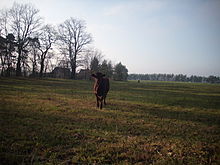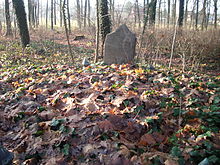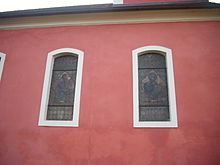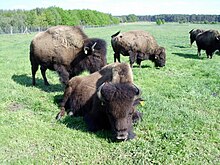Krügersdorf
|
Krügersdorf
City of Beeskow
Coordinates: 52 ° 9 ′ 15 ″ N , 14 ° 18 ′ 55 ″ E
|
|
|---|---|
| Height : | 51 m above sea level NN |
| Residents : | 179 |
| Incorporation : | December 6, 1993 |
| Postal code : | 15848 |
| Area code : | 03366 |
Krügersdorf ( Lower Sorbian Krygaŕejce ) is a district of the town of Beeskow in the Oder-Spree district in Brandenburg .
geography
The village is located about 5 kilometers east-southeast of the Beeskow city center, surrounded by forests and fields. At the cemetery there is a large bison enclosure around the former mill property. To the east of the village with access from Krügersdorf is the ammunition depot Schneeberg , which is a restricted area .
Surrounding places are Grunow and Dammendorf in the east, Oelsen in the southeast, Reudnitz in the south, Zeust and Kummerow in the southwest, Beeskow with Bahrensdorf in the west, as well as the Beeskow districts Oegeln and Schneeberg in the northwest and north.
history
General
The village of Krügersdorf is mentioned for the first time in 1344 as Krugersdorph . At that time, the city of Beeskow was confirmed by the Margrave of Brandenburg , Ludwig the Elder , their rights and their eastern district described, which bordered Krügersdorf. The village has always had a manor , the owners of which also held the patronage of the church. Up until the Thirty Years' War there were 3 farmers and 15 Koßäts in the village , of whose farms only nine were still inhabited in 1652. At that time the fields of the farmers were turned into a knight's seat, which is why there have only been Koßäts in Krügersdorf since then, to which a few Büdner were added in the 18th century . The place had its own windmill , construction of which began in 1534 and which existed as such until the beginning of the 20th century. Today there is a private residential property at their location.
On December 6, 1993, Krügersdorf was incorporated into Beeskow.
The owners of Krügersdorf
In 1369 a Claws [Klaus] van Crugerstorph is mentioned for the first time , who is believed to have been the owner of the place. The first owners known by name were the Herren von Große. When Johann von Biberstein attacked the town of Beeskow in 1425 because of his homage to the hereditary family, Botho (von) Grosse, who had been to Crugersdorff , helped him . Three years later a Hans (von) Große and in 1483 the brothers Heinrich and Friedrich (von) Große are mentioned as owners. The last of this family was Simon (von) Große, who lost Krügersdorf in the 1530s to the then owner of the Beeskow estate and Bishop of Lebus , Georg von Blumenthal .
The next owner was Hans von Steinkeller , who came from Lebus , where his family owned several estates. He was captain of Beeskow in 1534 and in the same year was enfeoffed with Krügersdorf by the Bishop of Lebus, Georg von Blumenthal. The manor house was also built during this period, and the year 1539 can still be read in the bay window (top center). The initials "A. v. S. “seem to have been added later by the royal major general Anton Abraham von Steinkeller (1714–1781). According to the list of horse services in Storkowschen and Beskoschen Weichbilde in 1583 , Georg v. Steinkeller zu Krugersdorff provided an armored horse. But it was not well passed.
On the night of October 31, 1823, a fire broke out in the manorial house in which three servants were killed. A wooden plaque written on it from one of the unfortunate people is still preserved today. For generations the von Steinkeller were the junkers of Krügersdorf and later also Birkholz ( Friedeberg / Neumark district ). Some of the family members were buried in the so-called Steinkellerchen hereditary burial under the local church, which was heavily devastated during the Second World War . After more than 300 years in the possession of the Lords of Steinkeller, Friedrich Wilhelm Ludwig Lehmann became the landlord of Krügersdorf around 1845 .
In addition to the property in Krügersdorf, Ferdinand Möhring was also the tenant of the Beeskow domain and the Gramzow estate , which belonged to the Karbe family. In June 1901, he also leased the Blankenburg estate , formerly Karbe. The tombstone in Krügersdorfer Park seems to belong to him. His son was Hermann Möhring (* July 1, 1872 in Beeskow; † August 2, 1943 in Krügersdorf). As the last owner of the manor, which in 1929 had an area of 755 hectares , his heirs were expropriated after the Second World War. His wife Melitta was killed in a low-flying attack on the refugee route on April 24, 1945.
Pastor Johannes Aisch , who worked in Krügersdorf from 1902 to 1912, received the feudal letters from the Krügersdorf landowner widow to work through and reproduced them in the first part of his handwritten chronicle as a copy. Without this work there would be no knowledge of the letters from 1534, 1578, 1599, 1609 and 1620 today.
The church of Krügersdorf
Shortly after the first mention of the place is a church in 1346 Crügersdorff in the Meissen diocese matrikel called. Some time later in 1362 even the Archpriest of Sedes Beeskow officiated here. With Burchard Lehmann (around 1558) begins the long line of Protestant pastors of the place, whose parish has also included Schneeberg and Oelsen since the earliest times . After the Peace of Prague in 1635, the state border between Brandenburg and Saxony ran precisely through the parish district , as the village of Oelsen was under the Saxon Order of St. John Friedland , while the other two were Brandenburg. In 1738, the Prussian king certified the Krügersdorf pastor at his request that he may make a short trip to Saxon cities ( Friedland ) in Oelsen matters .
The plastered building was erected in 1720, and the year can be found in the gable of the south portal. Its appearance is that of 1910. The tower with its pyramid roof contains three bells that were cast in Bochum in 1922 . The spire consists of a sphere, a weather vane , a morning star and a cross. The year 1956 is a reminder of structural measures that were carried out on the tower, among other things. Substantial reconstructions took place from 2000 to 2002, during which the wooden supporting structure of the nave , the tower and the roof were renovated. In further measures from 2007 to 2009, the east and west gallery and the baptismal angel were restored.
Inside the church there is a patron's box with medallion pictures and tall, narrow, ornate columns. The middle parapet shows a picture of Salvator Mundi . The pulpit altar is connected to a gallery and the organ Opus 405 by the organ builder Wilhelm Sauer from 1883. The sound cover is carried by two angels . In the chancel there is a six-sided wooden baptism . In the middle of the nave hangs a baptismal angel from the baroque period . Between 1883 and 1887, 13 colorful lead-glazed church windows were donated by the landowner Ferdinand Möhring, six are still preserved.
The church of Krügersdorf was added to the list of architectural monuments in Beeskow . At the end of the 1990s, the former parish offices of Grunow and Merz were merged with Krügersdorf.
Economy and Infrastructure
- Schools and all necessary facilities, offices and authorities can be found in Beeskow, about 5 km away.
- In the renovated manor house there are holiday apartments and the village community room. A large playground has been created right next to the building at the park.
- The Germanic nave is located in the village . A restaurant and guesthouse that takes you into the world of the Middle Ages as an experience gastronomy . There is a medieval bathhouse and a brushwood - oven as a special feature. There are nature trails and herb walks to impart knowledge about medicinal herbs , and there is also a large fallow deer enclosure .
- The GbR Krügersdorfer Hirschgut operates a deer and bison farm .
- In Krügersdorf, horse lovers will find the opportunity to go on horseback safaris and ranch vacations , or to learn intuitive horse training. The riding stable is a cooperation partner of the IHK Ostbrandenburg and the University Viadrina in Frankfurt (Oder) .
traffic
Krügersdorf is on the federal highway 246 between the town of Beeskow and the town of Schneeberg.
Krügersdorf is part of the Berlin-Brandenburg transport association . Bus 400, the Oder-Spree bus service, is available for public transport.It runs between Beeskow and Eisenhüttenstadt and stops in all towns along the route. The nearest train stations are Schneeberg (near Beeskow) and Beeskow on the Frankfurt (Oder) –Königs Wusterhausen railway line .
Attractions
Not far from the town are the probably oldest oaks in Brandenburg with an estimated age of up to 600 years. One of them, the thick oak, is the seventh of the thickest oaks in Germany and has a chest height of 10.26 m (2016).
literature
- Hans-Joachim Beeskow : Guide through the Protestant churches in the parish of An Oder and Spree . Heimat-Verlag, Lübben 2002, ISBN 3-929600-25-0 , p. 178ff
- Carl von Eickstedt: Contributions to a newer land book of the Brandenburg brands: prelates, knights, cities, fiefdoms, or Roßdienst and fiefdom. Creutz, Magdeburg 1840 (hereinafter Eickstedt, land book with corresponding page number)
- Klaus Koldrack: Dispute over hunting rights, why Abraham von Steinkeller apologized to the Beeskower council because of a hare shot . In: Brandenburger Blätter , supplement of the Märkische Oderzeitung for leisure and vacation between Oderbruch and Havelland, Uckermark and Spreewald; Guide through the Brandenburg nature and culture, past and present, issue 175 of April 23, 2004, p. 13
- Adolph Friedrich Riedel , Codex diplomaticus Brandenburgensis: Collection of documents, chronicles and other source writings, Berlin 1861, part 1 vol. 20, p. 340ff ( the lordships of Beeskow and Storkow ). The following documents were used in the history section : Document XX-1369 (p. 353), Document LXIV-1425 (p. 387), Document LXXI-1432 (p. 397) and Document CXIV-1483 (p. 439 ).
Web links
- Krügersdorf on the website of the city of Beeskow
- Contribution to the RBB program Landschleicher on December 16, 2007
References and comments
- ^ Walter Wenzel : Niederlausitzer Place Name Book . Domowina-Verlag , Bautzen 2006, p. 70
- ^ Friedrich Beck : Documents from the city of Beeskow in Regesten (1272–1649). European Science Publishing House, Frankfurt am Main 2003, p. 33 (Urk. 13)
- ^ Directory of the subjects of the Beeskow office from 1652 (Landreiterbericht), ed. Karl Schramm (= sources on the rural farm and clan research 14) Goslar 1938, p. 31/32.
- ^ Lehnsbrief from 1534, copy by Pastor Johannes Aisch in the Krügersdorfer Chronik (begun in 1901), p. 4, Krügersdorf parish archive.
- ↑ B 246 - that is not Irmer's address. In: Märkische Oderzeitung , February 18, 2010
- ↑ Federal Statistical Office (Ed.): Municipalities 1994 and their changes since 01.01.1948 in the new federal states . Metzler-Poeschel, Stuttgart 1995, ISBN 3-8246-0321-7 .
- ↑ Sigmund Wilhelm Wohlbrück : History of the former Diocese of Lebus and the land of this taking, to be found by the author , Berlin 1829-1832, p. 444
- ^ Adolph Friedrich Riedel: Codex diplomaticus Brandenburgensis : Collection of documents, chronicles and other source documents. Berlin 1861, part 1 vol. 20, chap. XLVI. Diocese and Land of Lebus (from p. 178). Many documents on the von Steinkeller family can be found here.
- ^ Lehnsbrief from 1534, copy by Pastor Johannes Aisch in the Krügersdorfer Chronik (begun in 1901), pp. 3–5, Krügersdorf parish archive.
- ↑ s. a. Old Prussian Infantry Regiment No. 26 (1806)
- ↑ Eickstedt, Landbuch, p. 95 Online at Google Books
- ↑ Krügersdorfer Kirchenbuch (1822-1851), p. 154 [31. October 1823]. The wooden panel inexplicably mentions November 31, 1823 as the date of death.
- ↑ From 1846 baptisms of his children can be found in the Krügersdorfer church book
- ^ Paul Niekammer: Goods address book , Volume VII, Province of Brandenburg, 1929 Leipzig
- ↑ Hans Friedrich von Ehrenkrook : Genealogisches Handbuch des Adels , Volume 26, CA Starke Verlag 1961, p. 386
- ^ Information from the Krügersdorf parish archives
- ↑ Otto Posse : The Margraves of Meissen and the House of Wettin up to Konrad the Great. Leipzig 1881, p. 420
- ^ Subunit of an archdeaconate
- ^ Rudolf Lehmann : Studies on the history of the church organization and administration of the Lausitz in the Middle Ages. Colloquium-Verlag, Berlin 1974, ISBN 3-7678-0339-9 , p. 115
- ↑ Otto Fischer: Evangelical Pastor's Book for the Mark Brandenburg since the Reformation . Ed .: Brandenburg Provincial Synodal Association. First volume. E. S. Mittler & Sohn, Berlin 1941, p. 66 .
- ↑ Pfarrarchiv, Acta personalia (Kruger Strand pastors), p.2
- ↑ Angels count in Krügersdorf. In: Märkische Oderzeitung , August 20, 2009
- ↑ Wolf Bergelt (ed.), Martin Schulze: Orgel Handbuch Brandenburg , Volume 5: Oder-Spree. ISBN 978-3-937378-11-4 , p. 216
- ↑ Playground according to children's wishes. In: Märkische Oderzeitung , June 22, 2009
- ^ Jörg Kühl: Farm shop instead of amusement park. In: Märkische Oderzeitung , May 11, 2010
- ^ Entry in the directory of monumental oaks . Retrieved January 10, 2017









